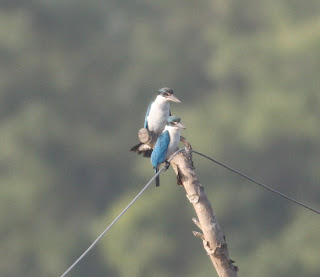Labour Day in The Philippines means a day off work, so I picked up Richard and Claire at 5, and we headed off to San Juan. We started at the main ponds north of the main house, which had a large flock of
Philippine Duck as well as a fair number of
Black-winged Stilt. In amongst them was a bird with a strongly marked black head and hind neck. Most of the Stilts we have in The Philippines are
H. h. himantopus. In juvenile plumage they have dark greyish hind-neck and cap which fades as they age to a pure white head and neck.
H. h. leucocephalus (aka
White-headed Stilt) also occurs, in adult plumage they have a black hind-neck and ear-coverts extending to the eye. This bird however had these features plus an all black crown.
We continued around the ponds, finding a good selection of San Juan birds, including
Grey-tailed Tattler, Marsh Sandpiper, Greenshank, Pink-necked Green Pigeon, Clamorous Reed Warbler, Pacific Golden Plover.
Putative
H. h. leucocephalus and
H. h. himantopus adults
.
The black hind-neck does not connect with the black mantle. In the fore-ground is a young
H. h. himantopus with a
greyish crown.
A juvenile
H. h. himantopus with a dark crown, ear-coverts and hind neck.
Pacific Golden Plover, breeding plumage and non-breeding plumage
White-collared Kingfisher
Slaty-breasted Rail
 Lowland White-eye
Mud Skipper
Lowland White-eye
Mud Skipper sp.
 Lowland White-eye
Lowland White-eye






Well worth the effort to get out birding early, then !
ReplyDeleteStilt photos are very interesting Paul, I can only imagine they can be leucocephalus but why with this combination of features? Was the mantle as black from all angles as it appears in the pictures? Maybe they have a second summer plumage?
ReplyDeleteBtw do you have any other photos of leucocephalus from the Philippines?
The mantle was jet black, and very sharp edged, quite unlike the many juvenile birds nearby that had a more smudged neck. I got the impression that is was slightly bigger than the others, but that impression may have been because of its behaviour which was quite aggressive. The whole time we were watching there was a small group (5 or 6 birds) that were behaving in an odd manner, appearing to be mock fighting, and generally quite excitable. This individual was in the thick of this group the whole time (but not necessarily the centre of the melee).
ReplyDeleteI saw leucocephalus near Zamboanga with Tim in 2008, but that was before I had a decent camera so no pictures I'm afraid!